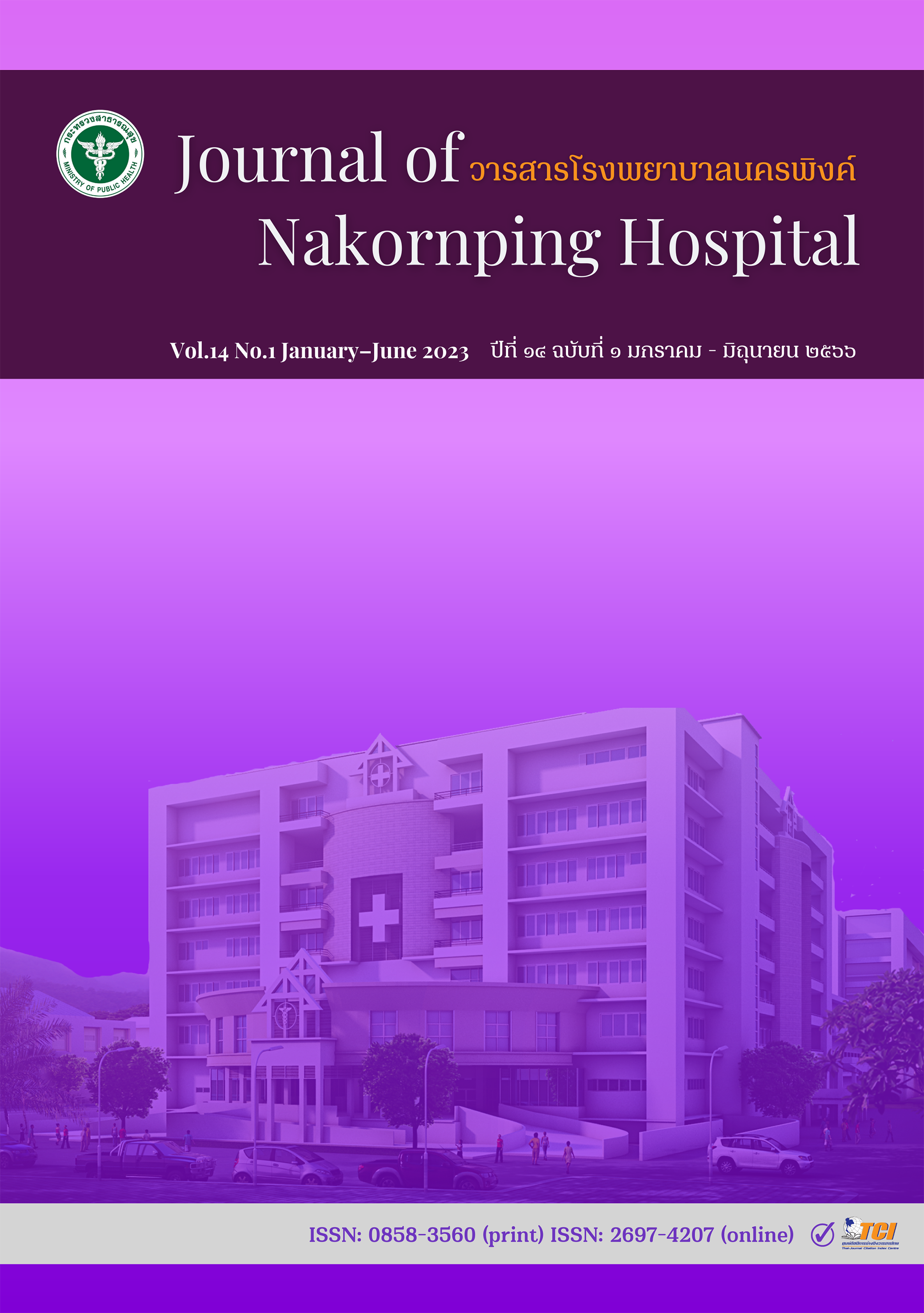Effectiveness of Emergency Neonatal Service System Improvement, Nakornping Hospital, Chiang Mai Province
Keywords:
system improvement, emergency care, neonate, Nakornping HospitalAbstract
An effective emergency referral system can reduce the morbidity and mortality rates of patients.
The objective was to study the guidelines for improving the newborn emergency referral system at Nakornping Hospital and the outcomes of system enhancements in terms of nurses' knowledge and skills, satisfaction, response time to emergency referral system, equipment readiness, coordination, success in resuscitation, and complications such as hypothermia and endotracheal tube displacement.
Method: A quasi-experimental research was conducted during 1 August 2021 – 30 June 2022. The sample group consisted of 15 professional nurses from the Neonatal Intensive Care Unit1 and newborn infants who received emergency referral care, 56 patients in pre-implementation and 56 patients in post-implementation period. The research was conducted in three phases: preparation phase, system improvement and experimentation phase, and evaluation phase. The research tools included a simulated scenario training base, an emergency assistance manual, task assignments, and outcome measurements, including nurses' knowledge and skills in emergency assistance, satisfaction, response time to emergency assistance, and a comparison of complications and success in resuscitation
Results: Total 15 nurses enrolled into the newborn emergency referral system improvement; their average knowledge score were significantly higher after the system implement (p < 0.05). The overall compliance to the specified guidelines in practice was 73.68, while incomplete-compliance was 26.32 The overall satisfaction with the system improvement was high. The response time for emergency assistance after the system improvement was significantly faster than before (p < 0.001). In terms of patient outcomes, the occurrence of hypothermia was decreased statistically significant differences (p < 0.005). However, there was no significant difference in equipment readiness and dislodgement of tubes and mortality rates
Conclusion: The results from this study can help in improvement of the neonatal emergency service system. Furthermore, increase in the knowledge and skills of nurses and the quality of neonatal care can be further applied to improve the neonatal service network.
References
National institute for Emergency Medicine. Guidelines for compliance with criteria, criteria, and procedures for emergency patient separation and prioritization of care at the emergency room according to the criteria set by the CDC. Nonthaburi: National institute for Emergency Medicine; 2015. [In Thai]
Apiratwarakul K. Development of Emergency Medical Service. Srinagarind Med J. 2017;32(3):289-94. [In Thai]
Nilnuan P, Promasatayaprot V. The Development of Emergency Medical Service System of Emergency Operation Division in Kutsaicho Subdistrict Administrative Organization, Kantharawichai District, Maha Sarakham Province. Academic Journal of Community Public Health. 2020;6(3):97-107. [In Thai]
Limrangsikul A, Phongmee P. Neonatal resuscitation textbook. Bangkok: Thai Neonatal Society; 2012. [In Thai]
Buckaloo B, Crowson T, Hegwood G, Haden K. Development of a Neonatal Rapid Respond Team in a community Hospital. JOGNN. 2016;45(3S):S27. Available from: https://doi.org/10.1016/j.jogn.2016.03.076
Delong S, Jordan L, Snider D, Leist‐Smith M, Lipke J, Green D. Got Code Pink? Neonatal Code Response Team. JOGNN. 2013;42(Suppl 1): S39.
Sirikit P, Imnamkhao S. Development of A Transmission Model for Newborn with Respiratory Problems At Mahasarakham’s Network. MAHASARAKHAM HOSPITAL JOURNAL. 2021;18(1):122-31. [In Thai]
Copple S. Enhanced Neonatal Resuscitation Provider Course for Novice Learners. Nurs Womens Health. 2020;24(4):256-66. doi:10.1016/j.nwh.2020.05.009.
Vichaiya S, Thungjaroenkul P, Nantsupawat A. Developing Knowledge of Nurses by Using the Neonatal Resuscitation Electronic Book. Nursing Journal CMU. 2020;47(4): 384-95. [In Thai]
Jirapaet K. Temperature control in newborn. In: Punnahitanan S, editor. Critical Conditions in Neonates. Bangkok: Thai Neonatal Society.Active prins; 2016. p.1-17
Wyckoff MH, Aziz K, Escobedo MB, Kapadia VS, Kattwinkel J, Perlman JM, et al. Part 13: Neonatal Resuscitation: 2015 American Heart Association Guidelines Update for Cardiopulmonary Resuscitation and Emergency Cardiovascular Care. Circulation. 2015;132(18 Suppl 2):S543-60. doi:10.1161/CIR.0000000000000267
Mathai SS, Raju U, Kanitkar M. Management of Respiratory Distress in the Newborn. Med J Armed Forces India. 2007;63(3):269-72. doi:10.1016/S0377-1237(07)80152-3.
Teerarungsikul N. Nursing Care for Premature Infant. 3rd ed. Bangkok: P press; 2002. [In Thai]
Thai neonatal society. Newborn Care Guide 1: Basic newborn care. Bangkok: Thai neonatal society; 2018. [In Thai]
Thai neonatal society. Newborn Care Guide 2: Sick newborn care. Bangkok: Thai neonatal society; 2012. [In Thai]
Nakornping Hospital. Annual Report of Neonatal Intensive Care Unit. Chiang Mai: Nakornping Hospital; 2019-2021. [In Thai]
Neonatal network Lanna 1. Clinical Practice Guideline Clinical Nursing Practice Guideline. Chiang Mai: Nakornping Hospital; 2013. [In Thai]
Mekkaeo B. The Development of a Real-Time Data Analysis Kit for the Reliability of the Test (KR-20). Phang Nga Community College; 2020. [In Thai]
Wangsri K. The EMS system in Thailand. Srinagarind Med Journal. 2013;28(4 suppl):69-73. [In Thai]
Hibbs B, Bell MA. Collaborating to Create a Comprehensive Neonatal Resuscitation Form. JOGNN. 2015;44(1):23-34. Available from: https://doi.org/10.1111/1552-6909.12695
Downloads
Published
How to Cite
Issue
Section
License
Copyright (c) 2023 Nakornping Hospital

This work is licensed under a Creative Commons Attribution-NonCommercial-NoDerivatives 4.0 International License.
The articles that had been published in the journal is copyright of Journal of Nakornping hospital, Chiang Mai.
Contents and comments in the articles in Journal of Nakornping hospital are at owner’s responsibilities that editor team may not totally agree with.



